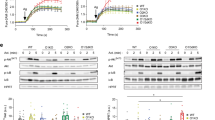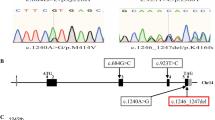Abstract
A nonsynonymous single nucleotide polymorphism (SNP) of the low-affinity IgE receptor (FcɛRII/CD23) gene resulting in an arginine to tryptophan exchange at amino-acid position 62 (R62W) has been associated with enhanced T-cell responses to antigen in allergic subjects. To explore the mechanism, a CD23(a) cDNA was cloned into the plasmid pCMVScript-CD23a-C with a C allele (R62). The pCMVScript-CD23a-T with T (W62) was produced using a site-directed mutagenesis approach. The pCMVScript-CD23a-C only (CC), mixture of pCMVScript-CD23a-T and pCMVSCript-CD23a-C (CT) and pCMVScript-CD23a-T only (TT) plasmids were transfected in Cos-7 cells at equivalence in transfection efficiency. No soluble CD23 was released from TT transfectants whereas a higher level of soluble CD23 was detected in CC than in CT transfectants. Human leukocyte elastase (HLE), cathepsin G, the dust mite allergen Der p I and ADAM 33 (A disintegrin and metalloproteinase) were found to cleave membrane CD23 in CC but not in TT transfectants, implying the resistance of CD23 to enzymatic cleavage associated with T mutant. Addition of tunicamycin resulted in the resistance of CD23 to Der p I mediated cleavage in CC but no change in TT transfectants. These results indicate that R62W influences the stability of membrane CD23 molecules due to possibly diminished N-glycosylation.
This is a preview of subscription content, access via your institution
Access options
Subscribe to this journal
Receive 6 digital issues and online access to articles
$119.00 per year
only $19.83 per issue
Buy this article
- Purchase on Springer Link
- Instant access to full article PDF
Prices may be subject to local taxes which are calculated during checkout





Similar content being viewed by others
References
Pirron U, Schlunck T, Prinz JC, Rieber EP . IgE-dependent antigen focusing by human B lymphocytes is mediated by the low-affinity receptor for IgE. Eur J Immunol 1990; 20: 1547–1551.
Flores-Romo L, Johnson GD, Ghaderi AA, Stanworth DR, Veronesi A, Gordon J . Functional implication for the topographical relationship between MHC class II and the low-affinity IgE receptor: occupancy of CD23 prevents B lymphocytes from stimulating allogeneic mixed lymphocyte responses. Eur J Immunol 1990; 20: 2465–2469.
Sarfati M, Delespesse G . Possible role of human lymphocyte receptor for IgE (CD23) or its soluble fragments in the in vitro synthesis of human IgE. J Immunol 1988; 141: 2195–2199.
Delespesse G, Hofstetter H, Sarfati M . Low-affinity receptor for IgE (FcɛRII, CD23) and its soluble fragments. Int Arch Allergy Appl Immunol 1989; 90: 41–44.
Gordon J . B-cell signalling via the C-type lectins CD23 and CD72. Immunol Today 1994; 15: 411–417.
Gordon J, Cairns JA, Millsum MJ, Gillis S, Guy GR . Interleukin 4 and soluble CD23 as progression factors for human B lymphocytes: analysis of their interactions with agonists of the phosphoinositide ‘dual pathway’ of signalling. Eur J Immunol 1988; 18: 1561–1565.
Dugas B, Mossalayi MD, Damais C, Kolb JP . Nitric oxide production by human monocytes: evidence for a role of CD23. Immunol Today 1995; 16: 574–580.
Lecoanet-Henchoz S, Gauchat JF, Aubry JP, Graber P, Life P, Paul-Eugene N et al. CD23 regulates monocyte activation through a novel interaction with the adhesion molecules CD11b-CD18 and CD11c-CD18. Immunity 1995; 3: 119–125.
Delespesse G, Sarfati M, Wu CY, Fournier S, Letellier M . The low-affinity receptor for IgE. Immunol Rev 1992; 125: 77–97.
Nakajima T, Sarfati M, Delespesse G . Relationship between human IgE-binding factors (IgE-BF) and lymphocyte receptors for IgE. J Immunol 1987; 139: 848–854.
Sarfati M, Nakajima T, Frost H, Kilccherr E, Delespesse G . Purification and partial biochemical characterization of IgE-binding factors secreted by a human B lymphoblastoid cell line. Immunology 1987; 60: 539–545.
Prinz JC, Endres N, Rank G, Ring J, Rieber EP . Expression of Fc epsilon receptors on activated human T lymphocytes. Eur J Immunol 1987; 17: 757–761.
Prinz JC, Rieber EP, Ring J . Loss of FceR2/CD23-expression on T and B lymphocytes during rush hyposensitization. In: Ring J, Braun-Falco O, Przybilla B (eds). New Trends in Allergy. Springer: Berlin, 1991, pp 105–108.
Jung CM, Prinz JC, Rieber EP, Ring J . A reduction in allergen-induced Fc epsilon R2/CD23 expression on peripheral B cells correlates with successful hyposensitization in grass pollinosis. J Allergy Clin Immunol 1995; 95: 77–87.
Roever AC, Henz BM, Worm M . Wasp venom rush immunotherapy induces transient downregulation of B cell surface molecule expression. Int Arch Allergy Immunol 2002; 127: 226–233.
Khan S, McClellan JS, Knutsen AP . Increased sensitivity to IL-4 in patients with allergic bronchopulmonary aspergillosis. Int Arch Allergy Immunol 2000; 123: 319–326.
Hakonarson H, Carter C, Kim C, Grunstein MM . Altered expression and action of the low-affinity IgE receptor FcepsilonRII (CD23) in asthmatic airway smooth muscle. J Allergy Clin Immunol 1999; 104: 575–584.
Dasic G, Juillard P, Graber P, Herren S, Angell T, Knowles R et al. Critical role of CD23 in allergen-induced bronchoconstriction in a murine model of allergic asthma. Eur J Immunol 1999; 29: 2957–2967.
Haczku A, Takeda K, Hamelmann E, Loader J, Joetham A, Redai I et al. CD23 exhibits negative regulatory effects on allergic sensitization and airway hyperresponsiveness. Am J Respir Crit Care Med 2000; 161: 952–960.
Laitinen T, Ollikainen V, Lazaro C, Kauppi P, de Cid R, Anto JM et al. Association study of the chromosomal region containing the FCER2 gene suggests it has a regulatory role in atopic disorders. Am J Respir Crit Care Med 2000; 161: 700–706.
Tantisira KG, Siverman ES, Mariani T, Xu J, Richter BG, Klanderman BJ et al. FCER2: a pharmacogenetic basis for severe exacerbations in children with asthma (submitted for publication).
Hewitt CR, Brown AP, Hart BJ, Pritchard DI . A major house dust mite allergen disrupts the immunoglobulin E network by selectively cleaving CD23: innate protection by antiproteases. J Exp Med 1995; 182: 1537–1544.
Brignone C, Munoz O, Batoz M, Rouquette-Jazdanian A, Cousin JL . Proteases produced by activated neutrophils are able to release soluble CD23 fragments endowed with proinflammatory effects. FASEB J 2001; 15: 2027–2029.
Elbein AD, Sanford BA, Ramsay MA, Pan YT . Effect of inhibitors on glycoprotein biosynthesis and bacterial adhesion. Ciba Found Symp 1981; 80: 270–287.
Kehry MR, Yamashita LC . Low-affinity IgE receptor (CD23) function on mouse B cells: role in IgE-dependent antigen focusing. Proc Natl Acad Sci USA 1989; 86: 7556–7560.
Heyman B, Tianmin L, Gustavsson S . In vivo enhancement of the specific antibody response via the low-affinity receptor for IgE. Eur J Immunol 1993; 23: 1739–1742.
Gustavsson S, Hjulstrom S, Liu T, Heyman B . CD23/IgE-mediated regulation of the specific antibody response in vivo. J Immunol 1994; 152: 4793–4800.
Karagiannis SN, Warrack JK, Jennings KH, Murdock PR, Christie G, Moulder K et al. Endocytosis and recycling of the complex between CD23 and HLA-DR in human B cells. Immunology 2001; 103: 319–331.
Boltz-Nitulescu G, Wiltschke C, Langer K, Nemet H, Holzinger C, Gessl A et al. Augmentation of IgE receptor expression and IgE receptor-mediated phagocytosis of rat bone marrow-derived macrophages by murine interferons. Immunology 1988; 63: 529–535.
Fourie AM, Coles F, Moreno V, Karlsson L . Catalytic activity of ADAM8, ADAM15, and MDC-L (ADAM28) on synthetic peptide substrates and in ectodomain cleavage of CD23. J Biol Chem 2003; 278: 30469–30477.
Van Eerdewegh P, Little RD, Dupuis J, Del Mastro RG, Falls K, Simon J et al. Association of the ADAM33 gene with asthma and bronchial hyperresponsiveness (comment). Nature 2002; 418: 426–430.
Shapiro SD, Owen CA . ADAM-33 surfaces as an asthma gene. New Engl J Med 2002; 347: 936–938.
Black RA, White JM . ADAMs: focus on the protease domain. Curr Opin Cell Biol 1998; 10: 654–659.
Zou J, Zhu F, Liu J, Wang W, Zhang R, Garlisi CG et al. Catalytic activity of human ADAM33. J Biol Chem 2004; 279: 9818–9830.
Powell RM, Wicks J, Holloway JW, Holgate ST, Davies DE . The splicing and fate of ADAM33 transcripts in primary human airways fibroblasts. Am J Respir Cell Mol Biol 2004; 31: 13–21.
Schulz O, Sutton BJ, Beavil RL, Shi J, Sewell HF, Gould HJ et al. Cleavage of the low-affinity receptor for human IgE (CD23) by a mite cysteine protease: nature of the cleaved fragment in relation to the structure and function of CD23. Eur J Immunol 1997; 27: 584–588.
Shakib F, Schulz O, Sewell H . A mite subversive: cleavage of CD23 and CD25 by Der p 1 enhances allergenicity. Immunol Today 1998; 19: 313–316.
Sarfati M, Rector E, Sehon AH, Delespesse G . In vitro synthesis of IgE by human lymphocytes. IV. Suppression of the spontaneous IgE synthesis by IgE-binding factors secreted by tunicamycin-treated RPMI 8866 cells. Immunology 1984; 53: 783–790.
Letellier M, Nakajima T, Delespesse G . IgE receptor on human lymphocytes. IV. Further analysis of its structure and of the role of N-linked carbohydrates. J Immunol 1988; 141: 2374–2381.
Begovich AB, Carlton VE, Honigberg LA, Schrodi SJ, Chokkalingam AP, Alexander HC et al. A missense single-nucleotide polymorphism in a gene encoding a protein tyrosine phosphatase (PTPN22) is associated with rheumatoid arthritis. Am J Hum Genet 2004; 75: 330–337.
Dierks SE, Bartlett WC, Edmeades RL, Gould HJ, Rao M, Conrad DH . The oligomeric nature of the murine Fc epsilon RII/CD23. Implications for function. J Immunol 1993; 150: 2372–2382.
Moulder K . The role of RGD in CD23-mediated cell adhesion. Immunol Today 1996; 17: 198–199.
Kijimoto-Ochiai S, Noguchi A . Two peptides from CD23, including the inverse RGD sequence and its related peptide, interact with the MHC class II molecule. Biochem Biophys Res Commun 2000; 267: 686–691.
Acknowledgements
We appreciate the assistance of Dr James Jones' lab (NJMRC) which provided EBV transformed B cells, of Dr Hongbin Shu's lab (NJMRC) which provided pAAV-lacZ plasmid and of Dr Shelby Umland (Schering-Plough Research Institute) which provided the pcDNA 3.1 ADAM33 plasmid. Dr Dennis Voelker's (NJMRC) advice regarding transfection experiments and the technical contribution of Ms Lin Cao are also appreciated. We are grateful to Dr Edward K Hill (PRA International) for professional editorial assistance and to Dr John Q Wang (UMKC School of Medicine) for reviewing this paper. This work was supported by an American Academy of Allergy, Asthma and Immunology Grant, 2004 AAAAI/Fujisawa Healthcare Allergic Skin Diseases Research Award and National Institute of Health Grant 1U01-GM/HL-61376.
Author information
Authors and Affiliations
Corresponding author
Rights and permissions
About this article
Cite this article
Meng, JF., McFall, C. & Rosenwasser, L. Polymorphism R62W results in resistance of CD23 to enzymatic cleavage in cultured cells. Genes Immun 8, 215–223 (2007). https://doi.org/10.1038/sj.gene.6364376
Received:
Revised:
Accepted:
Published:
Issue Date:
DOI: https://doi.org/10.1038/sj.gene.6364376
Keywords
This article is cited by
-
IgE in allergy and asthma today
Nature Reviews Immunology (2008)
-
CD23: An overlooked regulator of allergic disease
Current Allergy and Asthma Reports (2007)



